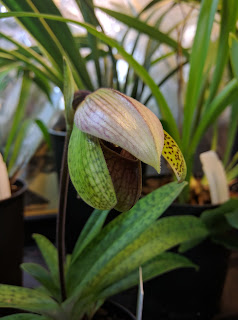Although I have been the custodian of this primary hybrid for some considerable time and have even bloomed it before, this is its Kev's Orchids blog debut. It is a hybrid between Paphiopedilum sukhakulii and Paphiopedilum charlesworthii and seems to have inherited some nice characteristics from both its parents. I have heard this hybrid described as 'good breeding stock but not one you'd grow on its own merit' but I think this is a rather unfair assessment. The plants are small and neat, flowers are large and on fairly short stems that are self-supporting, flowers are long lasting with attractive colour and markings and shape. They are temperature tolerant (which can't be said for at least one of its parents) and fairly forgiving of under and over watering. My only real criticism of it as a hybrid is that it is rather slow growing. This needn't be a problem in and of itself of course, provided the plant is also well -behaved and stays looking attractive while it is busy not flowering. Whilst bemoaning that it is a slow grower, it must be pointed out that it is by no means the slowest of Paphiopedilum; its just slower than most modern hybrids.
The main bone of contention from what I can see reading further afield (i.e. Google) is that this is just a weird combination of species and many hardcore Paphiopedilum growers (yes, they do exist) can be a bit vinegar-faced about such hybrids, and question why such crosses are made, as illustrated by the quote in the last paragraph. Whatever the initial reason for the cross, it seems a good way of getting the lovely spotting from P. sukhakulii in to modern complex hybrids and perhaps getting the lovely markings on the dorsal sepal into P. maudiae types. All of this is quite interesting to me because I find P. maudiae types quite ugly with mis-shapen flowers, at least to my eye, whereas P. Sue Worth produces a very neat flower.
I suppose, if I was to be super critical about it, I'd probably say that I'd like the dorsal sepal to be a bit bigger, and the lip to be a bit smaller. Then again, it is these imperfections that give the flower its personality and without them it would be too generic and I might as well go to a garden centre and buy something with no name. I also like the fact that it doesn't seem to mind the warm temperatures in my growroom which quite a few Paphiopedilum, especially the plain, strap leafed types (one of which is a parent of P. Sue Worth) seem to dislike. Mostly it stops them flowering well, rather than causing damage, but a non-blooming plant is of little use to me, even if it does grow well. Breeding temperature tolerance into modern hybrids is also a good thing, so that might be another idea behind the breeding of this hybrid.
As you can see, that flower is a good size for a plant that small. It is growing in a 9 cm pot and this is the second time it has bloomed in that pot. A new growth has already started, and I'm hopeful of a second new growth, too. Now we know that the plant will stay small and produce good sized flowers, we will have to wait and see how well it clumps up and whether a decent sized multi growth plant is possible with this hybrid.
One thing I always forget to mention with Paphiopedilum is how fascinating it is to watch the flowers open. More than any other orchid I grow, the flowers remind me of an egg cracking open and I always love to see the petals in the process of unfurling. I think the blooms are more beautiful at that time than they are at any other.
As well as showing the flower in the process of unfurling, the above photo also nicely shows how attractive the foliage is, a characteristic it has inherited from P. sukhakulii (P. charlesworthii has quite plain strap like foliage). Out of bloom, it could possibly be mistaken for a P. maudiae type, but the foliage is somewhat narrower, stiffer, and rather less glossy. I'd go so far as to say that this hybrid is rather more forgiving than P. maudiae can be, though it does help to get a healthy plant to start with.
Overall, I rather like this plant. Whether it will be a long-term keeper, I can't say but I certainly don't object to it taking up a small amount of space on my bench so I'm not in a hurry to get rid of it just yet.



That looks beautiful! I find them attractive more because of the challenges in getting them to bloom (for me). By comparison Paphs seem over-eager, lol.
ReplyDeleteThank you!
ReplyDeleteAs I keep harping on, I'm not so big a fan of slippers, but this one seems to earn its keep, so it is permitted to stay. It is a seed grown plant, and a friend of mine who has another from the same pod has a slightly differently shaped flower with a larger dorsal sepal. I'm quite jealous of him !